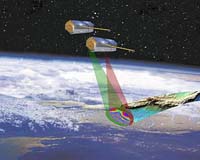 |
Rochester NY (SPX) Jun 16, 2009 With this week's scheduled launch of the Lunar Reconnaissance Orbiter, imaging technology from Eastman Kodak Company will again play a key role in the exploration of our solar system. Using images captured by KODAK CCD Image Sensors, the orbiter will be used to create a comprehensive atlas of the moon's features and resources to aid in the design of a future manned lunar outpost. The Lunar Reconnaissance Orbiter (LRO) is the first mission in NASA's Vision for Space Exploration program, designed to extend human presence in the solar system by returning first to the moon, with missions to Mars and beyond to follow. As the first step in this program, the LRO will provide high-resolution maps of the moon's surface, identify resources (such as water) on or near the surface that could be used by future astronauts, and better understand the radiation environment. Fundamental to the success of the mission are three cameras - developed by Malin Space Science Systems and based on KODAK CCD Image Sensors - that will provide images of the moon with an unprecedented level of clarity and detail. "Kodak has a long and rich history of participating in the space program, and we are proud to see this continue with the Lunar Reconnaissance Orbiter," said Michael Miller, manager of Kodak's CCD Image Sensor Business, part of the company's Image Sensor Solutions group. "The selection of KODAK CCD Image Sensors for this mission is a testament to the Kodak teams who design and manufacture all of our CCD devices, making them suitable for use in the demanding environment of space." "The Lunar Reconnaissance Orbiter has very challenging imaging requirements - half-meter resolution with the narrow angle camera and high spectral precision with the wide angle camera - and real cost and schedule constraints," said Michael Ravine, Advanced Projects Manager, Malin Space Science Systems (MSSS). "Designing the LRO cameras around Kodak commercial image sensors enabled us to meet those performance requirements on schedule and budget." The orbiter's Wide Angle Camera will provide a "big picture" view of the moon by capturing images with 100-meter resolution. Based on the KODAK KAI-1001 Image Sensor, a one-megapixel device that provides both high sensitivity and high dynamic range, this camera will also use seven different color bands to identify spectral signatures of minerals that may be present on the moon's surface. Two Narrow Angle Cameras on the orbiter will capture high-resolution images of the moon's surface at 0.5 meter-per-pixel using KODAK KLI-5001 Image Sensors, providing the same level of detail as the highest resolution satellite images of Earth commercially available today. As it fulfills its primary mission to map the surface of the moon, the LRO will also fly over landing sites from the historic Apollo missions, allowing these high-resolution cameras to capture the first images of Apollo-era artifacts from lunar orbit. From the first Earth orbits of the early 1960's to the exploration of our solar system today, Kodak has played a key role in providing scientists an indispensable tool for all levels of space exploration. KODAK Imaging Technology recorded John Glenn's reactions to travelling through space at 17,400 miles per hour as he became the first American to orbit the Earth in 1962. Kodak designed and built the photographic system used in the Lunar Orbiters from the mid-1960's, which scouted the moon for landing sites for the Apollo missions. And Kodak was a key part of the Apollo program, providing new films with special emulsions as well as photographic equipment for these historic missions to the moon. Today, KODAK CCD Image Sensors are used in cameras that fly with every Space Shuttle mission (including the upcoming STS-127 mission), by astronauts on the International Space Station both within crew compartments as well as on space walks, and in orbiters around both Mars and Venus. Upcoming space missions that will use KODAK CCD Image Sensors will include Mars Science Laboratory rover "Curiosity" and the Jupiter Orbiter "Juno," both scheduled for launch in 2011. Share This Article With Planet Earth
Related Links KODAK Space Technology News - Applications and Research
 German TanDEM-X Radar Satellite Now Complete
German TanDEM-X Radar Satellite Now CompleteBonn, Germany (SPX) Jun 16, 2009 In early 2009, Friedrichshafen-based aerospace company Astrium completed construction of the German radar satellite TanDEM-X. This satellite was created in collaboration with the German Aerospace Center . The satellite, five metres in length and weighing 1.3 tons, has now been transported to Ottobrunn, a town near Munich. In special-purpose test facilities operated by Astrium and IABG, the ... read more |
|
| The content herein, unless otherwise known to be public domain, are Copyright 1995-2009 - SpaceDaily. AFP and UPI Wire Stories are copyright Agence France-Presse and United Press International. ESA Portal Reports are copyright European Space Agency. All NASA sourced material is public domain. Additional copyrights may apply in whole or part to other bona fide parties. Advertising does not imply endorsement,agreement or approval of any opinions, statements or information provided by SpaceDaily on any Web page published or hosted by SpaceDaily. Privacy Statement |